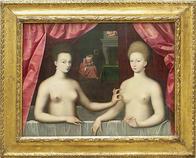
Gabrielle d’Estrées and One of Her Sisters
British historian David Starkey has blasted the costume drama The Tudors for falsifying history, calling it “a brutal dumbing down” and “armpit TV.” Even the costumes are faux: more Elizabethan than Tudor. Sure The Tudors plays fast and loose with the facts, but David Sessions chides us for our naivety in expecting truth from television, saying “So everyone is saying The Tudors isn’t historical. Why should it be?” Tudors creator Michael Hirst admits he turned it into a soap opera to get people to watch. Viewers are not only “eating it up,” but are dressing in costume to join Henry VIII (Jonathan Rhys Meyers) or Anne Boleyn (Natalie Dormer) in a clinch in the show’s Portrait Gallery.
The Tudors plunders art as well as history. Early on, Anne’s brother propositions two of the queen’s maids of honour, using some frank modern language (season 1, part 6). Not long afterwards, he enters his bedchamber to find the two girls perched on top of his bed in the nude. One sister is tweaking the other’s nipple, an image stolen from a late 17th-century painting, Gabrielle d’Estrées and One of Her Sisters. The Louvre wasn’t blind to the power of this gesture either, since this was the image chosen for its Carte Louvre Jeunes in 2007.
According to historian Starkey, the academy-award winning film, A Man for All Seasons (1966), is also “terrible history, but at least it has a point.” Paul Scofield turned in a virtuoso performance as Sir Thomas More and Robert Shaw is an equally masterful Henry VIII–substantial in frame, though light on his feet. Conceit takes place in the next century, but I mention Sir Thomas More in it since John Donne was a distant relation. Although his wife Ann More was not, her maiden name was too tempting, so I invented a connection, hinting that their daughter Pegge’s unusual character might result from this commingling of blood. At the end of Conceit, I acknowledge my own departures from history, saying that this is my seventeenth century, and in a recent guest blog at Sandra Gulland’s Baroque Explorations, I talk about the way facts bred, producing fiction as I wrote my novel.
